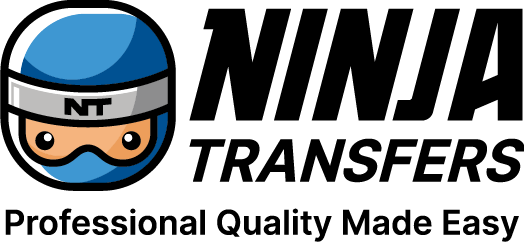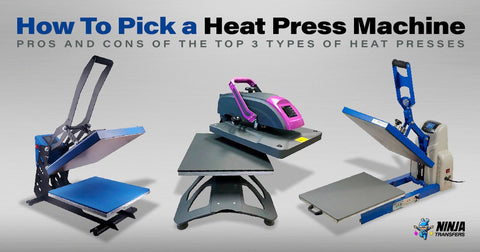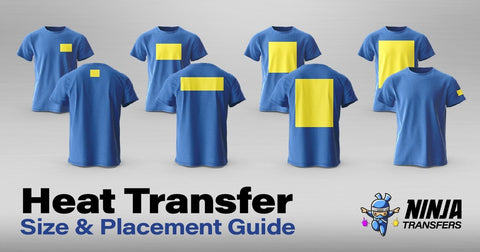No matter what type of heat transfers being applied, you need a heat press machine to bond the transfer to the apparel. Matching the many heat press variables like size, type, and functionality with your specific needs can feel overwhelming, so we’ve created this simple guide on how to pick a heat press.
Setting aside the impact picking the right shirt heat press can have on your business, it’s important to remember one simple thought:
All heat press machines do the same thing. They provide consistent heat and pressure for a specified amount of time.
3 Important Features
Heat presses are available in a wide range of configurations with many features, but we’ve simplified the list down to the three most important. In our experience, considering these features first is the best place to start.
Print Area Size

The size of the print area will determine what apparel can be printed. Not only should current projects be considered, but also potential future projects to ensure that your equipment is ready.
There are 5 heat press sizes that should be considered:
Very Small: Often referred to as a “label press,” this size ranges from 4”x 6”, 6” x 6” and 6” x 8”. This heat press is best for small items like baby clothes and awkward items like tote bags with seams. In addition, a small heat press can be used on shirt sleeves or very large items where heat is only needed in a small area.
Small: With sizes ranging from 9” x 12”, 11” x 15” and 12” x 14”, 14”x 16” small heat presses are inexpensive and marketed mainly to hobbyists. This size is a good choice for applying 8.5” x 11” heat transfers, patches, and other small items.
Medium: Including sizes of 16” x 16” and 15” x 15” , these t-shirt heat presses are large enough to do the work for most decorators and considered a “standard” size. Not only do they offer greater wattage to easily complete repetitive prints, but they’re also much less expensive than the next size up.
Large: A 16” x 20” heat press is considered large; few apparel decorators have a need for anything larger. This press easily does 11” x 17” transfers as well as standard sizes for t-shirt designs, like full front, and full back. These can also accommodate names and numbers for sports teams.
Note: This size is often the starting point for most salespeople, but it’s expensive and often too much.
Very Large: Ranging in size from 18” x 20” to a gigantic 40” x 64”, these presses are larger than what most need and very expensive. This is not a reasonable heat press for t-shirts in our opinion, so seek professional guidance if you’re considering this size.
Understanding the sizes of the products to be customized is crucial to making the right decision for you. Generally, you want your press to be approximately 1 inch bigger than the largest graphic in each dimension. Standard size will be anything larger than 14” x 16”, since it’ll have a heating element large enough to accommodate the majority of projects most professional printing shops will encounter.
Heat Press Type
Clamshell, Swing-Away, and Draw are the three major types of t-shirt heat press machines. While the Clamshell may be the most popular, each type has strengths and weaknesses. Consider this summary of each type to determine how it may fit your needs.
Clamshell Presses: Clamshell heat presses are available in a range of sizes and are popular due to their simplistic design. Featuring an upper and lower plate, or platen, this shirt press is manually operated by applying downward pressure. While the two platens make this device resembles a clam (hence the name), the upper and lower platen construction can affect the print on specific products.
Benefits of a Clamshell heat press include portability, affordability, and the limited space needed for operation. Drawbacks include issues printing thicker items and an increased chance of garment burns for those configured with rigid platens.
Swing-Away Presses: Offering greater versatility, these t-shirt heat presses lift away from the garment and then pivot to the right. The mechanism is integrated into the top platen, which is the portion that moves 90° - 100° to provide access to the garment being printed.
Benefits of the Swing-Away heat press include greater versatility for a wider range of garments, less likely to burn garments, and additional functionality, Drawbacks include a larger amount of space required for operation, a heavier weight (making it less portable), and cost.
Draw Presses: The Draw heat press is unique by combining characteristics of both a clamshell and swing away heat press. It features a manually operated top platen with a lower surface that slides forward. Many suggest that it offers the “best of both worlds.”
The Draw press' benefits include its limited footprint, faster operation, and greater versatility. The biggest downside is cost.
Each type of t-shirt heat press offers its own set of benefits. Clamshell presses are the most affordable, Swing-Aways are useful to higher-quantity production environments, and Draw presses combine the best of both. To get the most accurate information, we recommend comparing the manufacturer’s specs of each item.
Quality Construction
Print size and press type don’t mean much if your equipment doesn’t function, so quality construction is important for any t-shirt heat press. While quality equipment costs more, this can be controlled by focusing on features that best suit your needs. Some indicators of quality construction include:
Metal Construction - A steel or aluminum construction is the first indication that a heat press is well constructed. A simple web search shows that there are countless presses constructed of plastic, which will fail under regular use.
Cast Aluminum Heating Plate - High-quality shirt presses produce even, predictable heat across the entire heating surface, and cast aluminum performs well. The highest quality presses embed heating rods into the aluminum plate to distribute heat evenly. A rule of thumb used by many is that higher-quality machines often weigh over 100 lbs (due to the heavy platens).
Manufactured in the United States - Imported t-shirt heat presses are acceptable for use of up to 30 hours per week, but a commercial, US - manufactured brand tends to be more durable. Some brands to consider include:
- Stahl’s,
- HIX
- Geo Knight & Co.
- Insta Graphics
Safety Certification - Lower-quality apparel heat presses do not possess common safety certifications, which constitute a red flag. Look for equipment with a UL or ETL electrical safety certification whenever possible.
Avoid Heating Coils in a Z Pattern - Many cheap or imported heat presses have heating coils placed in a “Z” pattern. The result is uneven heat and cold spots that lead to poor results.
Avoid Equipment With No or Limited Warranty - Many t-shirt heat presses are manufactured by companies unwilling to stand behind their products. While we understand that budgets for equipment may be limited, purchasing equipment with no warranty is no way to save money, in our opinion.
Other Features of Importance
Although heat press size, type, and quality are the most critical features, there are many others that should be considered. Usability features focus on the ease of use in everyday operation, while Needs-Specific relates to the use of a heat press for a specific purpose.
Usability
Easy opening and closing: The amount of effort needed to operate a shirt heat press varies widely and should be considered. From auto-opening manuals to air automatics that run on compressed air, an easy-to-operate press reduces staff fatigue and increases production capacity.
Digital time and temperature: Digital controls are an improvement over traditional analog dial controls. Not only are they more accurate, but they’re easier to operate. Digital controls aren’t necessarily an essential item, but they simplify the pressing process and make it more efficient
Elevated lower platen: Many heat presses have an elevated lower platen, which makes mounting shirts and applying multiple transfers easier. You’ll find Hotronix® and Mighty Press® Digital presses have this ability, as well, the HIX HT-400D, HT-600D and the Knight DC16.
Wattage: The amount of power applied to the heating element can delay reheating of the platen between prints. Ensure that any press has adequate wattage, especially smaller presses.
Pressure Setting: The ability to set the required pressure is helpful when printing tops that have different thicknesses. Many decorators develop a “feel,” but printing that way can be inconvenient and not repeatable by others. Some presses offer functionality that can automate pressure settings, like Stahls’ Hotronix press line, Geo Knight swing-away presses, and HIX’s SwingMan 20D.
Needs-Specific
Weight: For those that ever need mobility, the weight of a t-shirt heat press can be both a benefit or drawback. Because of manufacturing differences, the same-size heat press can vary greatly in weight. These examples are all excellent pieces of equipment, but their weight varies dramatically:
Pneumatic Drive: High-volume apparel printers often use heat presses with a pneumatic drive to ease the physical work required for printing. Comparable to power steering for a vehicle, compressed air performs most of the work. The 16” x 20” size in clamshell and swing-away configurations are the most common.
Different Sized Platens: Printing differently sized garments well can require platens sized for the purpose. Therefore a t-shirt heat press should have the flexibility to change platens to fit that need.
Variable Thickness: Most decorators customize garments of varying thicknesses, so a heat press that can meet that need will be useful. It’s important to focus on one that will meet the need. Using the 16” x 20” size as an example, the Hotronix Swinger & Draw accepts up to 2”, the HIX Swingman 20D 1½”. and the Knight DK20S 1”. So understanding a heat press’ capacity is helpful in picking the right one depending on whether you're pressing
custom patches, DTF transfers or other types of apparel.
Attachments for Other Products: An almost unlimited number of other product types can be customized using a heat press commonly used for shirts, so consider every model’s expandability. Among the most popular other products are baseball caps and coffee mugs, but there are many others including shoes, notebooks, and promotional products.
Pick the T-Shirt Heat Press That Best Meets Your Needs
Selecting the right heat press for your needs can feel complicated, but applying common sense with our recommendations will simplify the process. First, understand the type of garment you’ll be customizing. Second, focus on the three most important factors. Finally, adjust to any other features of importance. The result will be the best heat press available based on your needs.









Comments (0)
There are no comments for this article. Be the first one to leave a message!